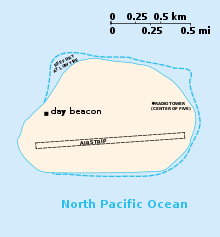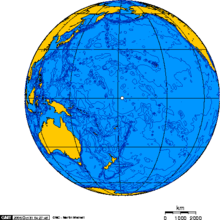
Baker Island
Background to the schools Wikipedia
This Schools selection was originally chosen by SOS Children for schools in the developing world without internet access. It is available as a intranet download. SOS Children has looked after children in Africa for forty years. Can you help their work in Africa?
Baker Island (pron.: / ˈ b eɪ k ər /) is an uninhabited atoll located just north of the equator in the central Pacific Ocean about 3,100 kilometers (1,700 nmi; 1,900 mi) southwest of Honolulu. The island lies almost halfway between Hawaii and Australia, and is a possession of the United States. Its nearest neighbour is Howland Island, 68 km (37 nmi; 42 mi) to the north.
Located at 0°11′41″N 176°28′46″W. the island covers 2.1 km2 (0.81 sq mi), with 4.9 km (3.04 mi) of coastline. The climate is equatorial, with little rainfall, constant wind, and strong sunshine. The terrain is low-lying and sandy: a coral island surrounded by a narrow fringing reef with a depressed central area devoid of a lagoon with its highest point being 8 meters (26 ft) above sea level.
The island now forms the Baker Island National Wildlife Refuge and is an unincorporated and unorganized territory of the U.S. Its defense is the responsibility of the United States; though uninhabited, it is visited annually by the U.S. Fish and Wildlife Service. For statistical purposes, Baker is grouped with the United States Minor Outlying Islands.
Description
A cemetery and rubble from earlier settlements are located near the middle of the west coast, where the boat landing area is located. There are no ports or harbors, with anchorage available only offshore. The narrow fringing reef surrounding the island can be a maritime hazard, so there is a day beacon near the old village site. Baker's abandoned World War II runway, 1,665 m (5,463 ft) long, is completely covered with vegetation and is unserviceable.
The United States claims an Exclusive Economic Zone of 200 nmi (370.4 km; 230.2 mi) and territorial sea of 12 nmi (22.2 km; 13.8 mi) around Baker Island.
During a 1935–1942 colonization attempt, the island was most likely on Hawaii time, which was then 10.5 hours behind UTC. Since it is uninhabited the island's time zone is unspecified, but it lies within a nautical time zone 12 hours behind UTC.
History
Baker was discovered in 1818 by Captain Elisha Folger of the Nantucket whaling ship Equator, who called the island "New Nantucket". In August 1825 Baker was sighted by Captain Obed Starbuck of the Loper, also a Nantucket whaler. The name goes back to Michael Baker, who visited the island in 1834. Other references state that he visited in 1832, and again on August 14, 1839, in the whaler Gideon Howland, to bury an American seaman.
The United States took possession of the island in 1857, claiming it under the Guano Islands Act of 1856. Its guano deposits were mined by the American Guano Company from 1859 to 1878. John T. Arundel and Company, a British firm using a competing claim to the island by the UK, made the island its headquarters for guano digging operations in the Pacific from 1886 to 1891. To clarify American sovereignty, Executive Order 7358 was issued on May 13, 1936.
In 1935, a short-lived attempt at colonization was begun. The American colonists arrived aboard the USCGC Itasca, the same vessel that brought colonists to neighboring Howland Island, on April 3, 1935. They built a lighthouse, substantial dwellings, and attempted to grow various plants. One sad-looking clump of coconut palms was jokingly called King-Doyle Park after two well-known citizens of Hawaii who visited on the Taney in 1938. This clump was the best on the island, planted near a water seep, but the dry climate and sea birds, eager for anything upon which to perch, did not give the trees or shrubs much of a chance to survive. King-Doyle Park was later adopted as a geographical name by the USGS.
The settlement was named Meyerton after Captain H.A. Meyer of the United States Army, who helped establish the camps in 1935. It had a population of four American civilians, who were all evacuated in 1942 after Japanese air and naval attacks. During World War II it was occupied by the U.S. military.
LORAN Station Baker
LORAN station Baker was a radio operations base in operation from September 1944 to July 1946. The station unit number was 91 and the radio call sign was NRN-1.
Flora and fauna
Baker has no natural fresh water sources. It is treeless, with sparse vegetation consisting of four kinds of grass, prostate vines and low-growing shrubs. The island is primarily a nesting, roosting, and foraging habitat for seabirds, shorebirds, and marine wildlife.
Baker Island is home to a number of threatened and endangered species. The ruddy turnstone, bar-tailed godwit, sanderling, bristle-thighed curlew and Pacific golden plover, considered species of High Concern on the national conservation priority scheme, are shorebirds that inhabit the island. Green turtles and hawksbill turtles, both threatened, can be found along the reef.
Seabird species such as the lesser frigatebird, brown noddy and sooty tern use the island for nesting and roosting. The island is also believed to be a rest stop for arctic-breeding shorebirds.
National Wildlife Refuge
On June 27, 1974, Secretary of the Interior Rogers Morton created Baker Island National Wildlife Refuge which was expanded in 2009 to add submerged lands within 12 nautical miles (22 km) of the island. The refuge now includes 531 acres (2.15 km2) of land and 410,184 acres (1,659.96 km2) of water. Along with six other islands, the island was administered by the U.S. Fish and Wildlife Service as part of the Pacific Remote Islands National Wildlife Refuge Complex. In January 2009, that entity was upgraded to the Pacific Remote Islands Marine National Monument by President George W. Bush.
Environmental challenges include abandoned military debris from World War II and illegal fishing offshore. Invasive exotics introduced by human activity, including cockroaches and coconut palm, have also displaced native wildlife. Feral cats, first introduced in 1937, were eradicated in 1965.
Public entry to the island is only by special use permit from the U.S. Fish and Wildlife Service and it is generally restricted to scientists and educators. Representatives from the agency visit the island on average once every two years, often coordinating transportation with amateur radio operators or the U.S. Coast Guard to defray the high cost of logistical support.
Ruins and artifacts
Debris from past human occupation is scattered throughout the island and in offshore waters. Most is from the U.S. military occupation of the island from 1942 to 1946. The most noticeable remnant is the 150-foot (46 m) wide, 5,400-foot (1,600 m) long airstrip. It is completely overgrown with vegetation and is unusable. In the northeast section, apparently the main camp area, are the remains of several buildings and heavy equipment. Five wooden antenna poles about 40 feet (12 m) in height remain standing in the camp. Several crashed airplanes and large equipment such as bulldozers are scattered around the island. Numerous bulldozer excavations containing the remnants of metal, fuel, and water drums are scattered about the north central portion and northern edge of the island. The Navy reported the loss of 11 landing craft in the surf during World War II.




